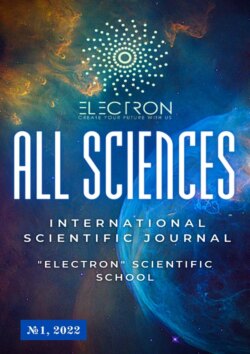Читать книгу All sciences. №1, 2022. International Scientific Journal - Ibratjon Xatamovich Aliyev - Страница 3
PHYSICAL AND MATHEMATICAL SCIENCES
GENERAL PRESENTATION OF THE LCA-EPD-20 ACCELERATOR
ОглавлениеBoxodir Xoshimovich Karimov, Candidate of Physical and Mathematical Sciences, Associate Professor of the Faculty of Physics and Technology of Fergana State University
Ferghana State University, Uzbekistan
E-mail: b_karimov48@mail.ru
Annotation. Since the necessary research was carried out in the field of searching for such a source and method of energy generation, nuclear reactions were finally recognized as a solution that would increase their own cross-section, therefore, both the probability of passing the reaction itself and the number of active reactions, which of course is directly related to the overall efficiency of the entire nuclear reaction. What follows when taking into account that the energy of the flying particles from the nuclear reaction, in the entire tuple of particles, is the total voltage, and the number of flying particles, due to their charge, creates a parameter of the current strength of the system. Then, as a consequence of this, it is possible to identify the need to create a special accelerator LCC-ED-20, for carrying out the above-mentioned nuclear reactions.
Keywords: science, research, resonant nuclear reactions, physics of the atomic nucleus and elementary particles.
Аннотация. Поскольку проводились необходимые исследования в области поиска подобного источника и метода генерации энергии, то наконец решением были признаны ядерные реакции, которые бы увеличивали собственное сечение, следовательно, как вероятность прохождения самой реакции, так и количество действовавших реакций, что конечно же напрямую связано с общей эффективностью всей ядерной реакции. Что вытекает при учёте, что энергия вылетающих частиц из ядерной реакции, во всём картеже частиц, это общее напряжение, а количество вылетающих частиц, благодаря их заряду создаёт параметр силы тока системы. То, как следствие из этого можно выявить необходимость создания специального ускорителя ЛЦУ-ЭПД-20, для проведения вышеуказанных ядерных реакций.
Ключевые слова: наука, исследование, резонансные ядерные реакции, физика атомного ядра и элементарных частиц.
Fig. 1. Three-dimensional model of the accelerator LCA-EPD-20
Due to the fact that the energies are selected in such a way that after passing the Coulomb barrier, the particle has an energy equal to the energy of its thermal counterpart and this fact alone increases the effective cross-section of the entire nuclear reaction into which the particle enters, then such nuclear reactions can be called resonant, due to the fact that they cause resonance in the system and only this increase the overall efficiency of the entire process.
Resonant nuclear reactions were first discovered in September 2021, after which active research was carried out, which led to a number of publications, the most significant of which was made in December 2021, which is the monograph of Aliyev I. H. and Sharofutdinova F. M. “The use of accelerators and phenomena of collisions of elementary particles with high-order energy for generating electric energy. The Electron Project”, which led to research in the field of searching for this method for 12 years, taking into account that the search in the field of atomic nucleus and elementary particle physics, as well as quantum physics, took place for a significant 5 years. The name of resonant nuclear reactions was given to these systems in January 2022 by Karimov Bokhodir Khoshimovich and appeared for the first time in this research.
Due to the fact that the relevance of resonant nuclear reactions quickly follows from the above, it remains to prove the relevance of the fact that a charged particle accelerator, a special type of LCA (Linear Cyclotron Accelerator), its class EPD-20, is necessary for the implementation of these nuclear reactions, it follows from the parameters that proton and deuterium beams are beams in it the Electron project with an energy of up to 20 MeV. Due to the fact that the energy must be selected, for example, for a conventional nuclear lithium-6 bombardment reaction with the release of two alpha particles, it is necessary to have a proton with an energy of 1.613245483 MeV, and only in this case it will be assumed that the final energy of the proton, after passing the Coulomb barrier at the nuclear radius, will be 0.25 eV, thanks to what does a proton become, what is called “thermal” and the effective cross-section of this nuclear reaction is already measured in huge units – kBn.
But today there is no LCC class accelerator on the whole planet, not to mention a detailed type of accelerators, having a common LCA-EPD-20 encoding, which could give a proton energy equal to 2,312691131 MeV for the first resonant nuclear reaction during the implementation of the Electron project, 1,978142789 MeV for the second resonant energy, 1,613245483 MeV for the third and 4.457595117 MeV for the fourth reaction, not because this energy is not achievable, by no means, this energy is scanty in accelerator physics, since modern particle accelerators appear with energies in GeV and TeV. The reason for the difficulty of achieving such results is precisely accuracy, accelerators can impart energy of 1 MeV, 1.5 MeV or 2 MeV, that is, specific values whose accuracy does not exceed 1 or 2 orders of magnitude, and as can be seen from calculations in an early monograph, much greater accuracy is needed to carry out these resonant nuclear reactions, which and it will be provided in the new LCA-EPD-20 accelerator of the Electron project.
Bibliographic list
1. Aliev I. H., Sharafutdinov F. M. The use of accelerators and the phenomena of collisions of elementary particles with high-order energy to generate electrical energy. The Electron Project: A monograph. Publishing solutions. Reader, 2021. – 594 p.
2. Aliev I. H. New parameters for nuclear reactions to be carried out on an accelerator of charged particles of the LCC-EP-300 type. The Electron Project: A monograph. Publishing solutions. Reader, 2022. – 498 p.
3. Aliyev I. H. Software modeling of nuclear reaction phenomena based on technologies for creating a set of data using a system of algorithms in C++. The Core-COMPUTER project: A monograph. Publishing solutions. Reader, 2022. – 156 p.
